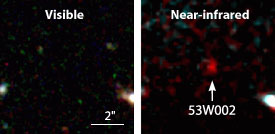
The light from a very distant Hyper-Extremely Red Object, designated HERO1, has been redshifted so much that it can be seen in the near-infrared (right) but not at visible wavelengths (left). HERO1 is located in the sky very close to a radio source, known as 53W002, that is more than 10 billion light-years away.
Courtesy Myungshin Im (Caltech).
For several years now, astronomers have studied the farthest reaches and earliest days of our universe using the full sensitivity of large telescopes both in space and on the ground. These “deep fields” have revealed faint, enigmatic features — dubbed Extremely Red Objects (EROs) — that some researchers claim to be more than 13 billion light-years away and thus among the very first galaxies in cosmic history. The ruby hues arise because their radiation has been enormously redshifted by the expansion of the universe.
But new results suggest that these objects are actually significantly closer to us. According to Myungshin Im (Caltech), some of the few dozen EROs discovered thus far are so red that all of their light is emitted at infrared wavelengths, making them fully invisible to optical or even near-infrared telescopes. Toshinori Maihara (Kyoto University, Japan) coined the name HEROs (Hyper-EROs) for these redder-than-red objects. Using the Japanese 8.2-meter Subaru Telescope on Mauna Kea, Hawaii, Maihara and his colleagues discovered four HEROs in the Subaru Deep Field — a small patch of sky in the constellation Coma Berenices. Im located another HERO and three HERO candidates close to the radio galaxy 53W002 on the border of Hercules and Draco, using data from both Subaru and the Hubble Space Telescope’s NICMOS infrared camera.
There are two possible causes for these objects' extreme color, says Im. They might be extremely distant, as previously assumed, or they might be much closer to us and simply colored red by huge reservoirs of dust obscuring our view. To distinguish between the two possibilities, Kristen Coppin and Mark Halpern (University of British Columbia, Vancouver) observed the Subaru Deep Field HEROs with the submillimeter SCUBA camera at the James Clerk Maxwell Telescope, also on Mauna Kea. Relatively close, dusty galaxies are expected to be much brighter at millimeter wavelengths than extremely remote, redshifted ones.
When the four HEROs turned up the SCUBA observations, Coppin and Halpern concluded that they are dusty star-forming galaxies at distances of a “mere” 10 billion light-years or so. Im plans to check out the HEROs in Coma using NASA’s Space Infrared Telescope Facility (SIRTF), due to be launched in April. But he already suspects that those are likewise reddened by dust. If they were instead remote, highly redshifted building blocks of primordial galaxies, it'd be statistically very unlikely to find four of them so close to an unrelated radio galaxy. Instead, the foursome are probably part of the same cluster of galaxies to which 53W002 belongs.
So is the HERO riddle solved? Not yet, says Im. Extremely redshifted objects can still be found, possibly by Hubble’s successor, the James Webb Space Telescope, which may be sensitive enough to measure the redshifts of extremely distant galactic precursors. And even if all extremely red objects are relatively nearby, their color may be due to their sheer age, rather than dusty veils. Either way, HEROs are going to shed light on the star-formation history of the universe.
 0
0
Comments
You must be logged in to post a comment.